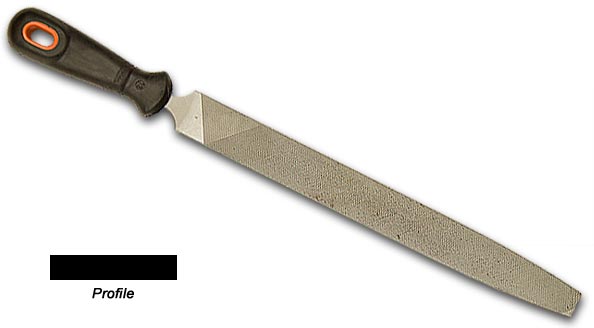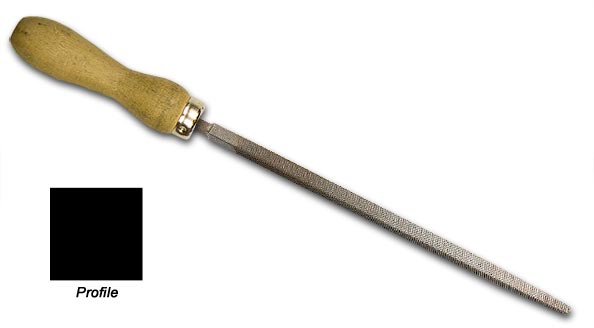Hand tools
Files
Files are cutting tools used to remove/smooth rough and sharp edges from cut metal. They are also used to file metal to shape or size. For each type of material there is an ideal tooth form that gives the most efficient cutting action.

Parts of a file
Parts of a file
- Point
- Face
- Shoulder
- Tang
- Length.
The features of a file are:
- length
- shape or kind
- grade or cut.
Length - measured from the point to the shoulder (does not include the tang).
Shape or kind - a files name is usually derived from its cross-sectional shape, eg square, flat, triangular, half round and round (small round are known as 'rat tails').
Grade or cut - files are graded according to the size and spacing of cutting teeth. There are three standard cuts in regular use:
- bastard - is a course file for roughing down work to a general shape where a good finish is not required
- second cut - used on hard metals, across narrow surfaces (more teeth in contact with the work), or for general work to close sizes requiring a reasonable finish
- smooth - produces a very fine finish.
An example of a correctly specified file is: 250mm flat second cut.
Applications
Flat file

Flat file
- sharpening tools
- cleaning relay contacts
- cleaning painted or rusted surfaces for earthing purposes.
Half round file

Half round file
- produce both flat and concave surfaces
- cleaning large steel conduits internally
- enlarging cable entry into cubicles etc.
Round file

Round file
- for opening up holes and finishing concave surfaces
- filing mounting holes for meters, lamps or switches in component case
- enlarging entries into motor connections boxes, switchboards, mounting blocks etc.
- slotting mounting holes.
Square file

Square file
- for making square and rectangular holes
- filing mounting holes for switches in component case
- filing keyways in pulleys, etc
- filing mounting holes for coach bolts.
Triangular files

Triangular file
- clearing out square corners and filing acute internal angles greater than 60 degrees
- re-shaping damaged threads on bolts and screws, etc.
File handles
File handles are generally made of plastic (wooden handles were commonly used). New files are often supplied without handles, but must not be used without a handle. This is to:
- avoid the danger of the tang piercing your hand
- give good control when using the file.
To fit a handle, select a handle to suit the length of the file. Insert the tang into the handle and then bang the end of the handle down onto a bench.
Care of files
- Keep files clean and dry.
- Never rap a file on a solid surface or strike it with a metal object.
- Never subject the file to bending or excessive pressure.
- Store files separately from each other and from other tools.
- Check that the handle is not split and that it fits securely.



